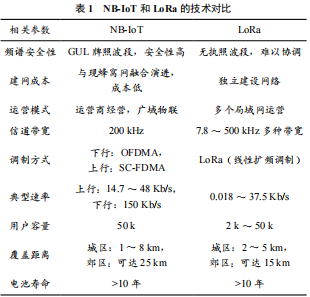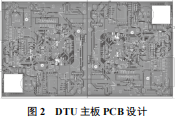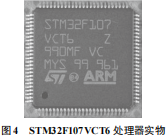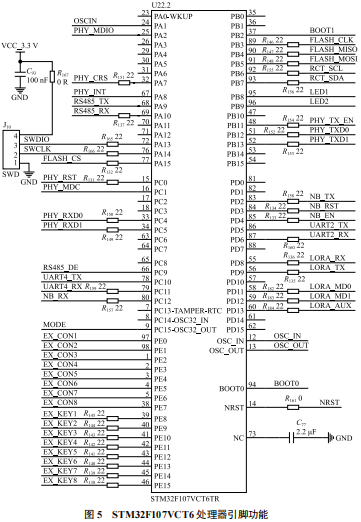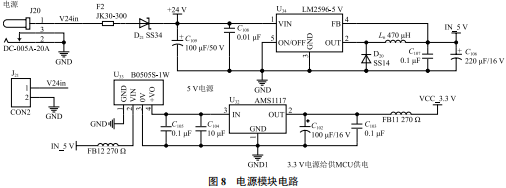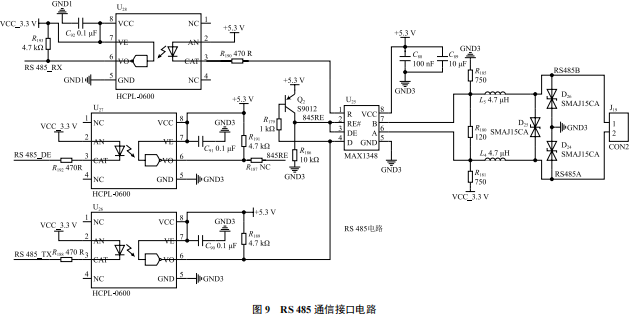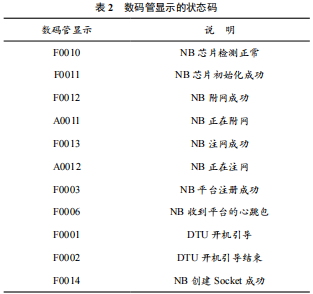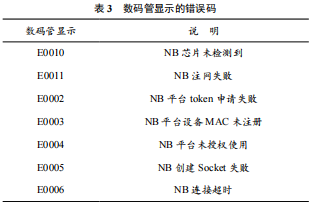Li Zhaoxiong, Zhang Chaoyang, Liu Hui, Luo Xuhui
(Fujian Academy of Agricultural Sciences, Agricultural Ecology Research Institute, Fuzhou, Fujian 350013)
Abstract: Tea gardens located in mountainous areas usually lack access to municipal electricity, and the network signals are relatively weak. In the ecological environment monitoring equipment for tea gardens, it is necessary to use the DTU (Data Transfer Unit) to upload collected sensor data to the cloud server via wireless networks. After data transmission is complete, various external sensors are turned off to save power. The DTU is crucial as the core of the habitat monitoring equipment for tea gardens. The DTU designed in this study has a timed on/off power supply function for external sensors, employs NB-IoT wireless transmission technology, has low power consumption, wide coverage, and requires minimal maintenance, making it suitable for tea gardens located in mountainous areas.
Keywords: NB-IoT; DTU; Habitat Monitoring; STM32F107VCT6; Data Transfer Unit; Parameter Configuration
Classification Number: TP39; TN919 Literature Identification Code: A
Article Number: 2095-1302 (2022) 08-0022-05
0 Introduction
In the ecological environment data monitoring device for tea gardens, the main function of the DTU is to periodically upload the monitoring data obtained from various external sensors to the cloud server through a communication module, and after data transmission is complete, to turn off the external sensors and communication module to achieve energy-saving purposes. The DTU designed here consists of a multi-interface data transfer unit with switch control and an NB-IoT (Narrow Band Internet of Things) network module, which is the core of the device and can achieve data collection and transmission. The performance of the DTU affects the reliability and availability of the entire device.
1 LPWAN and NB-IoT
After more than twenty years of development, IoT technology has rapidly evolved, with technologies like RFID, UWB, Bluetooth, ZigBee, WiFi, and 2G/3G/4G being widely applied. Based on transmission distance, RFID, UWB, and Bluetooth are classified as short-range transmission technologies, while ZigBee and WiFi are medium-range transmission technologies. For long-distance wide-area coverage IoT technologies, the main technology currently is cellular IoT technology, which utilizes mobile communication operators’ 2G/3G/4G networks to access the internet. Cellular IoT technology is usually the gateway for other IoT technologies to connect to the internet. It is worth noting that 2G/3G/4G were not originally designed for IoT applications; their initial purpose was for person-to-person communication, not for machine-to-machine connectivity, and their drawback is high power consumption.
Therefore, LPWAN (Low Power Wide Area Network) was born. LPWAN is a term for low-power wide-coverage technology characterized by long communication distances, low power consumption, and low network deployment costs, suitable for large-scale, non-real-time, low-data-volume communication scenarios.
Low-power wide-area access technology can be divided into two major camps based on implementation methods and frequency bands. One camp is represented by cellular IoT technologies such as NB-IoT and eMTC, which use authorized frequency bands; the other camp is represented by narrowband technologies such as LoRa, Sigfox, and Ingenu, which use unlicensed frequency bands. Among them, NB-IoT and LoRa are the most representative, and Table 1 provides a comparison of the technical parameters of NB-IoT and LoRa.
From Table 1, it can be seen that NB-IoT operates in authorized frequency bands, which relatively reduces interference and enhances security. In the same environment, NB-IoT has a longer coverage distance, and since NB-IoT uses the operator’s cellular network, data can be transmitted directly without the need for gateway devices. Overall, NB-IoT is more suitable for scenarios like mountainous tea gardens.
The DTU (Data Transfer Unit) designed here mainly consists of an STM32 microprocessor, an NB-IoT communication module, and control circuitry. The control circuitry turns on the power supply for the sensors at set times according to the embedded program, extracts various environmental data, and transmits the collected data to the cloud server via the NB-IoT module, storing the data in the server’s database. After data collection is complete, the power supply for the sensors is disconnected, and the NB-IoT network module enters sleep mode to reduce energy consumption. Environmental monitoring sensors include atmospheric temperature and humidity sensors, soil temperature and humidity sensors, carbon dioxide sensors, and light intensity sensors, with sensor interface communication adopting the Modbus protocol. The DTU is designed with a local network interface, allowing configuration via an RJ 45 interface.
The physical structure of the tea garden environmental data monitoring device is shown in Figure 1.
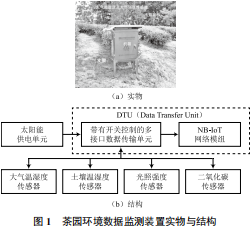
3 Hardware Design
3.1 Mainboard Design
For the DTU with an NB-IoT module, when designing the PCB, care should be taken to keep the power supply traces as far away from the RF section as possible, ensuring that the width of the main power supply traces can safely carry a current of 1A, and the ground plane of the power supply section should be as complete as possible with multiple grounding holes. When the signal is poor, the NB-IoT module may experience instantaneous high current situations, causing switch noise that can affect other circuits. To avoid such noise, isolation should be implemented at the power supply for the module and other circuits, using an LC filtering circuit with a winding inductor rated at 470µH and a current rating greater than 1.2A. The PCB design for the DTU mainboard is shown in Figure 2, and the physical DTU mainboard is shown in Figure 3.
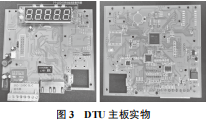
3.2 STM32F107VCT6 Processor
The STM32F107VCT6 processor is a 32-bit ARM chip with 64KB RAM and 256KB flash memory, offering good compatibility and high stability. Additionally, the chip integrates an Ethernet 10/100 MAC module (supporting MII and RMII), which, when connected to an external Ethernet physical layer interface chip DP83848IVVX, can form a complete Ethernet transceiver, facilitating parameter configuration and firmware upgrades via the Ethernet port. Thus, this chip can effectively meet the data collection, transmission, and control needs of the tea garden production environment monitoring equipment.
The physical STM32F107VCT6 processor is shown in Figure 4, and the pin functions of the STM32F107VCT6 processor are shown in Figure 5.
In this design, the control computer uses a relay switch to control the power supply of the external sensors, and in the embedded software, the time periods for powering the external sensors can be set. During the powered period, the sensors are activated, and the data returned from the sensors is collected. After data uploading is complete, the external sensors are turned off, and the DTU enters standby mode. The relay control circuit is shown in Figure 6.
3.4 NB-IoT Communication Module
This design adopts the Quectel BC95 communication module, which is a high-performance, low-power NB-IoT wireless communication module characterized by low power consumption, high sensitivity, compact size, and a wide operating temperature range, making it very suitable for outdoor working environments for agricultural production data monitoring.
The physical NB-IoT communication module and its principle are shown in Figure 7.
The DTU designed here operates in the field, and the temperature differences and humidity in mountainous areas can cause signal interference in the hardware circuits. Therefore, the power supply chips on the DTU mainboard use LM2596 and AMS1117. The AMS1117 operates in a fully feedback mode, providing better performance in power suppression compared to switching power supplies, especially effective in small signal processing circuits, with outstanding fast transient response and noise suppression advantages, and integrates overheat and overcurrent protection modules to ensure the reliability of the chip and system.
The power supply module circuit is shown in Figure 8.
3.6 485 Communication Interface
The I/O input interface uses high-precision optocoupler chips for isolation, reducing interference and improving system stability. The 485 communication interface employs MAX1348 series chips. The RS 485 communication interface circuit is shown in Figure 9.
3.7 Local Network Interface
The local network interface can quickly realize local configuration and management functions.
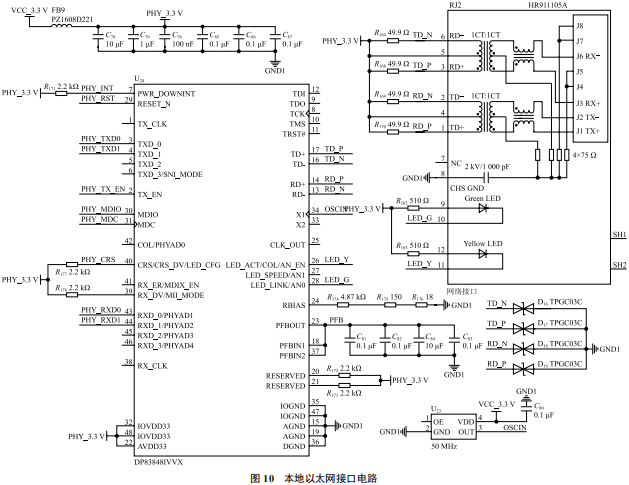
The embedded software for the data transfer unit completes initialization after the device is powered on, loads peripheral drivers, and starts the main program, activating the external sensors and the NB-IoT communication module through relay control. It retrieves sensor data through the Modbus interface and transmits the data to the remote data server via the NB-IoT network. After data transmission is complete, the sensors and communication module are turned off, and the device enters sleep mode, during which only the clock control part continues to operate. When the next preset clock cycle (which can be adjusted from 1 minute to 2 hours as needed) arrives, the peripheral drivers are reloaded to complete a new round of data collection and transmission. The flowchart of the DTU embedded program is shown in Figure 11.
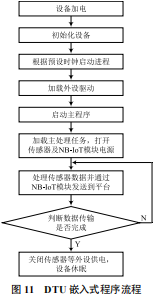
To facilitate debugging during outdoor deployment, the DTU is equipped with a 5-digit LED display, allowing for an intuitive understanding of the DTU’s operational status.
The status codes are listed in Table 2.
The error codes are listed in Table 3.
In practical applications, the DTU circuit board is installed in a metal casing, using interfaces to ensure stability during outdoor use. Figure 12 shows the appearance of the monitoring device and the installation diagram of the DTU (Data Transfer Unit) in the casing.
Currently, the system has been installed and used in the Wuyi Mountain rock tea production area and the Ningde white tea production area, providing stable and continuous monitoring of the ecological environment data in tea gardens.
With the development of IoT technology, the NB-IoT networks of the three major operators have become more mature. Field tests have shown that in major tea production areas in Fujian, most tea gardens can receive NB-IoT signals, especially with China Telecom having a wider signal coverage. In mountainous areas where 4G and 5G signals cannot reach, the use of NB-IoT technology has unique advantages, enabling remote continuous monitoring of tea garden habitat data in the hilly areas of Fujian where other monitoring methods are difficult to employ. The DTU design is simple and features low power consumption, wide coverage, and minimal maintenance. Through the design of the NB-IoT based DTU, the difficulty of monitoring system design has been reduced, facilitating the acquisition of habitat monitoring data in mountainous tea gardens, providing accurate, detailed, and continuous data for the management of tea cultivation in Fujian and related scientific research, and significantly promoting the refinement and digitization of tea cultivation.
Note: The corresponding author of this paper is Liu Hui.
[1] Dai Hui. Low Power Wide Area IoT Innovative Operation Model [J]. Information and Communication Technology, 2017, 11(1): 17-18.
[2] Shi Zhiguo, Pan Jun, Chen Jiming. NB-IoT Practical Guide [M]. Beijing: Science Press, 2019: 8.
[3] Li Chunyu. Closed Environment Air Quality Monitoring System [D]. Harbin: Harbin University of Science and Technology, 2016.
[4] Zhang Hong, Shen Mingxia, Lu Mingzhou, et al. Design of a Wearable ECG Monitoring System for Pigs [J]. Journal of Nanjing Agricultural University, 2016, 39(5): 872-879.
[5] Zheng Xiaoqing, Yang Rijie, Yang Liyong, et al. Design of Multi-Output DC-DC Circuit [J]. Foreign Electronic Measurement Technology, 2012, 31(9): 31-33.
[6] He Canlong, Shen Mingxia, Liu Longshen, et al. Design and Implementation of Intelligent Temperature Control System for Greenhouses Based on NB-IoT [J]. Journal of South China Agricultural University, 2018, 39(2): 117-124.
[7] Wang Yingqiang, Zhang Weigang, Wang Honggang. Design of Agricultural Data Collection System Based on NB-IoT [J]. Computer Technology and Development, 2020, 30(2): 206-210.
[8] Liu Chibiao, Li Nianyou, Lai Guoliang, et al. Development of Agricultural Production Monitoring Equipment Based on NB-IoT [J]. IoT Technology, 2021, 11(1): 61-64.
[9] Wang Zhanbei. Remote Monitoring System for Soil Temperature and Humidity in Tea Gardens Based on GPRS [J]. Agricultural Mechanization Research, 2013, 35(6): 186-189.
[10] Pan Leilei, Zhang Guiqing, Tian Chongyi, et al. Design of Agricultural Environment Monitoring System Based on NB-IoT [J]. Electronic Design Engineering, 2019, 27(1): 25-30.
[11] Ruan Xing, Tan Junwen, Chen Jinshui. Design of Tea Garden Monitoring System Based on NB-IoT [J]. Modern Information Technology, 2019, 3(11): 188-190.
Li Zhaoxiong (1969—), male, master’s degree, assistant researcher, research direction: agricultural informatization, smart tea gardens.
Zhang Chaoyang (1969—), male, bachelor’s degree, engineer, research direction: communication technology, digital agriculture.
Liu Hui (1969—), male, bachelor’s degree, associate researcher, research direction: machine vision, database development.
Luo Xuhui (1979—), male, master’s degree, associate researcher, research direction: ecological tea garden construction, green manure resources, and soil and water conservation.
